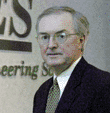SES taps Ross for growth

<FONT SIZE=2>Ron Ross has decided it's time to have some fun on the job.</FONT>

Scientific & Engineering Solutions' new president Ron Ross at the firm's Annapolis Junction office.
Laurie DeWitt
The 35-year veteran of the government information technology marketplace in September became president of Scientific & Engineering Solutions Inc., an Annapolis Junction, Md., systems integrator with 160 employees and about $21 million in annual revenue. Now Ross is developing plans to move this small player up in weight class.
SES, an 8(a) company founded in 1996 by Reginald Daniel, develops and upgrades computer software, systems and networks, with a focus on information assurance. Ninety percent of its revenue comes from work with the National Security Agency, including subcontract work for Computer Sciences Corp. on the Groundbreaker outsourcing contract.
Daniel, the chief executive officer, wants SES to reach $100 million in revenue within the next three to four years, so he brought in Ross to put the company on a fast growth path.
Ross "brings to us the ability to structure the organization to compete and win," Daniel said.
Ross came to SES from a two-year stint at the helm of Compaq Federal, the government arm of Compaq Computer Corp. Before that he was president and chief operating officer of CACI International Inc., Arlington, Va. He spent 15 years with Computer Sciences Corp., El Segundo, Calif., rising through the ranks to become president of its defense business. And he worked for the NSA.
With the purchase of Compaq by Hewlett-Packard Co., Palo Alto, Calif., Ross said he thought the new, combined behemoth would be concentrating on core businesses, such as selling hardware, rather than investing in the long-term development of government solutions. That made it a good time to move on.
"The choices that were available in the time frame that I was looking were all, 'Come in and run a status quo' kind of thing," Ross said. "I'm not a status quo kind of guy."
He decided that the engine of innovation would only keep running in small companies, where business decisions can be made quickly, outside any semblance of bureaucracy.
Fun, too, had to play a role.
"At CSC, where I started after NSA with seven guys [in my unit], I had as much fun then as I ever had in my life," Ross said.
Meanwhile, SES' Daniel was looking for ways to expand the company beyond its little corner of the government IT market, while remaining true to his vision of an employee-oriented company that could attract and retain industry's best and brightest.
"I felt that with the proper infrastructure and adequate capital, a company could do very well with that mission," Daniel said. "An ability to attract and retain the right talent ... would translate into the ability to win significant awards."
Now the challenge is to grow from a small company to one capable of winning large contracts as the prime. SES will seek to expand its government customer base outside the Defense Department, and then expand outside government with Fortune 500 companies, Daniel said.
Ross is eager to accept the challenge. While the overriding priority is to build the business, he said the critical step is to begin building a corporate just-in-time infrastructure that will allow SES to take on new work.
"What I find in a lot of small businesses, they get the growth, and then they start to think how they're going to support the growth," he said. "You can't just go hire a lot of people. ... When we say we're going to do something, we have the program staff to back it up."
Given SES' strong foothold at NSA, Ross said the company will look to serve other intelligence agencies, such as the Defense Intelligence Agency, making use of the cleared personnel it already has. On the civil agency side, Ross said, "We're looking at two or three agencies that we think will be vital for homeland security."
With no more than 160 employees, SES can't have a wide range of competencies, both Daniel and Ross said.
"If you look at how we express our core capabilities, we probably look like 50 other companies," Daniel said. "But what we've attempted to do is allow the customer to feel satisfied in every encounter, and that, I think, would be a significant differentiator."
For those in the integrator community who have worked with SES, the company's growth plans are welcome.
"They're an ethical company to do business with. They do a lot of IT kinds of things, but the reason I like to work with them is because of their ethics and the way they do business," said Tim Sheahan, president of the enforcement, security and intelligence division in CSC's federal sector. "They're not trying to work around me."
Sheahan said Ross will make a significant contribution to SES.
"Ron will bring some name recognition to a company that's been well thought of in a Maryland niche, and expand [that recognition] around the Beltway," Sheahan said. "He will help them get a lot more visibility, get in the door at a lot more agencies."
Sheahan said that SES, not Ross, may face the biggest challenge in the year ahead.
"Ron will run fast," he said. "Will the rest of the company keep up?" *
Staff Writer Patience Wait can be reached at pwait@postnewsweektech.com.
NEXT STORY: Private-sector solutions